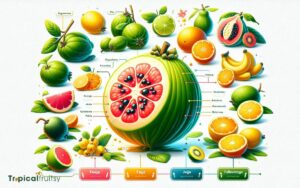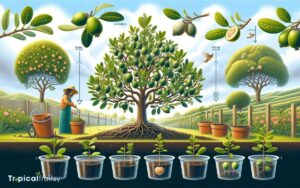How to Grow Feijoa from Fruit? 7 Easy Steps!
Propagating feijoa (pineapple guava) from fruit involves a series of steps, from seed extraction to planting and care. To successfully grow feijoa from fruit, select a fully ripe fruit and extract the seeds.
Clean and dry the seeds before initiating the germination process in a warm, moist environment. Once germinated, plant the seedlings in nutrient-rich soil and provide ample sunlight and water.
As the plants mature, transplant them to a suitable outdoor location and maintain them to prevent common issues, paving the way for a healthy feijoa harvest.
Growing feijoa from fruit is a process that includes these critical steps:
Cultivating feijoa from fruit requires attention to detail from seed to tree for a luscious, fruitful garden.
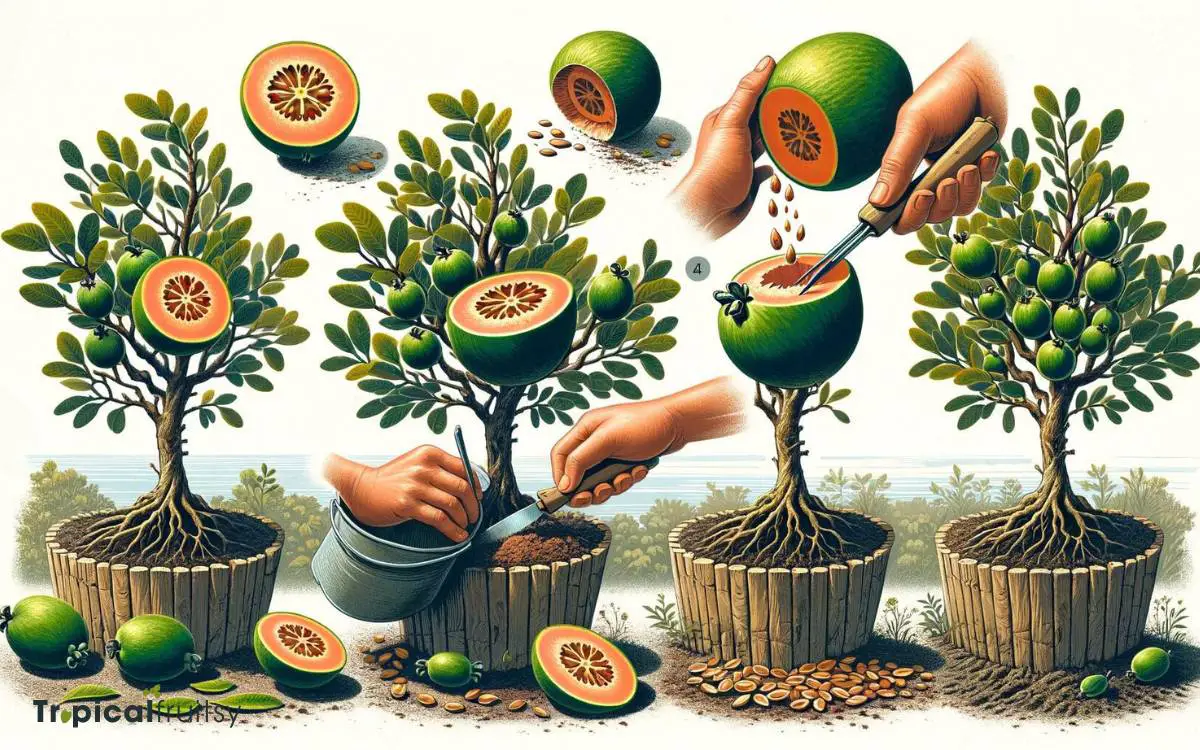
Key Takeaway
Step 1: Selecting the Right Feijoa
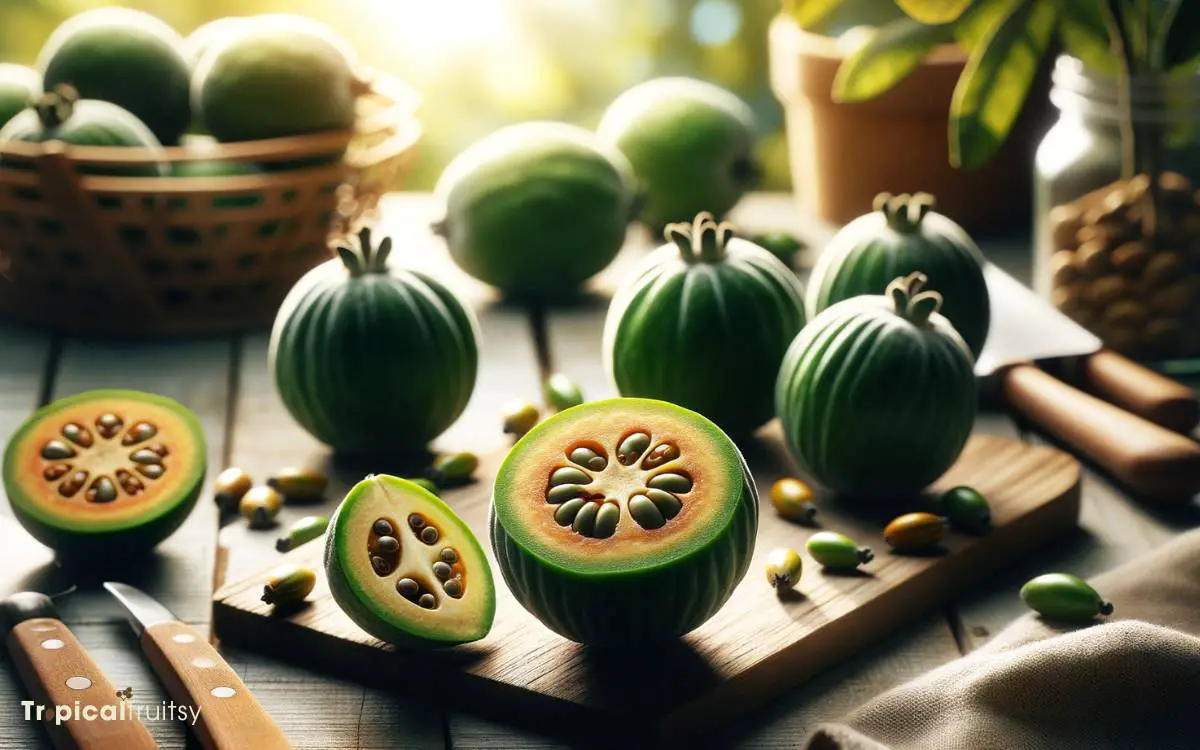
When you’re choosing a feijoa to grow from fruit, it’s essential to pick a ripe, healthy specimen for the best chances of germination.
The selected fruit must exhibit a rich, green exterior without any blemishes or signs of disease. It’s crucial that the feijoa gives a slight yield under gentle pressure, indicating maturity, yet retains firmness suggesting it’s not overripe.
As overripe fruits may house compromised seeds, they’re less likely to result in successful germination. Inspect for an aromatic fragrance, another indicator of ripeness.
Once selected, the fruit’s seeds should be extracted with care to avoid damage, then rinsed to remove pulp residues.
These steps ensure that you’re starting with the best possible candidate for propagation, maximizing the probability of cultivating a robust feijoa plant.
Step 2: Extracting and Preparing Seeds
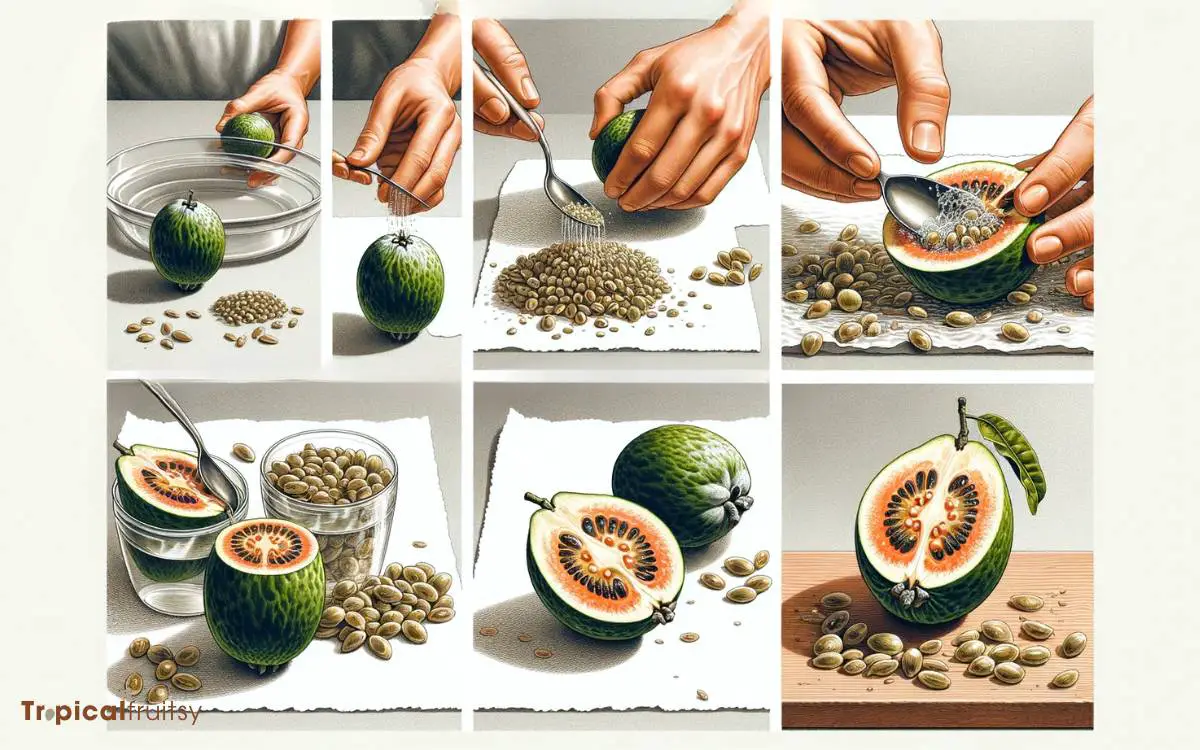
Upon harvesting a ripe feijoa fruit, one must carefully extract the seeds for propagation.
The seeds require thorough cleaning to remove pulp residue, which can inhibit germination if not properly cleansed. It’s also crucial to maintain specific temperature conditions that favor the seeds’ germination process.
Seed Cleaning Methods
To extract feijoa seeds for cultivation, first slice the fruit in half and scoop out the pulp into a fine mesh sieve.
Gently rub the pulp against the sieve’s sides, allowing the seeds to separate from the fleshy part. This method relies on the sieve’s grid to filter out the seeds.
Rinse the seeds under a gentle stream of water to remove any remaining pulp, which can inhibit germination if left attached. Once the seeds are clean, spread them out on a paper towel or a non-stick surface to dry.
Drying should be done in a well-ventilated area away from direct sunlight, as prolonged exposure can damage the seeds’ viability. Properly cleaned seeds are critical for successful germination and healthy plant development.
Germination Temperature Requirements
Feijoa seeds require a steady temperature range of 20-25°C (68-77°F) for optimal germination, with consistent warmth being crucial for their development.
To achieve successful germination, gardeners must ensure the seeds experience these conditions after extracting and preparing them for planting.
Here’s a detailed process:
- Extraction: Remove seeds from ripe feijoa fruit, ensuring they’re clean and free of pulp.
- Preparation: Soak the seeds in water for 24 hours to soften the outer coating and promote germination.
- Temperature Control: Place seeds in a propagator or a warm location that maintains the required temperature range. Monitor the environment, avoiding fluctuations that could hinder seedling growth.
These steps, grounded in horticultural best practices, facilitate the early stages of feijoa plant development.
Step 3: Germinating Feijoa Seeds
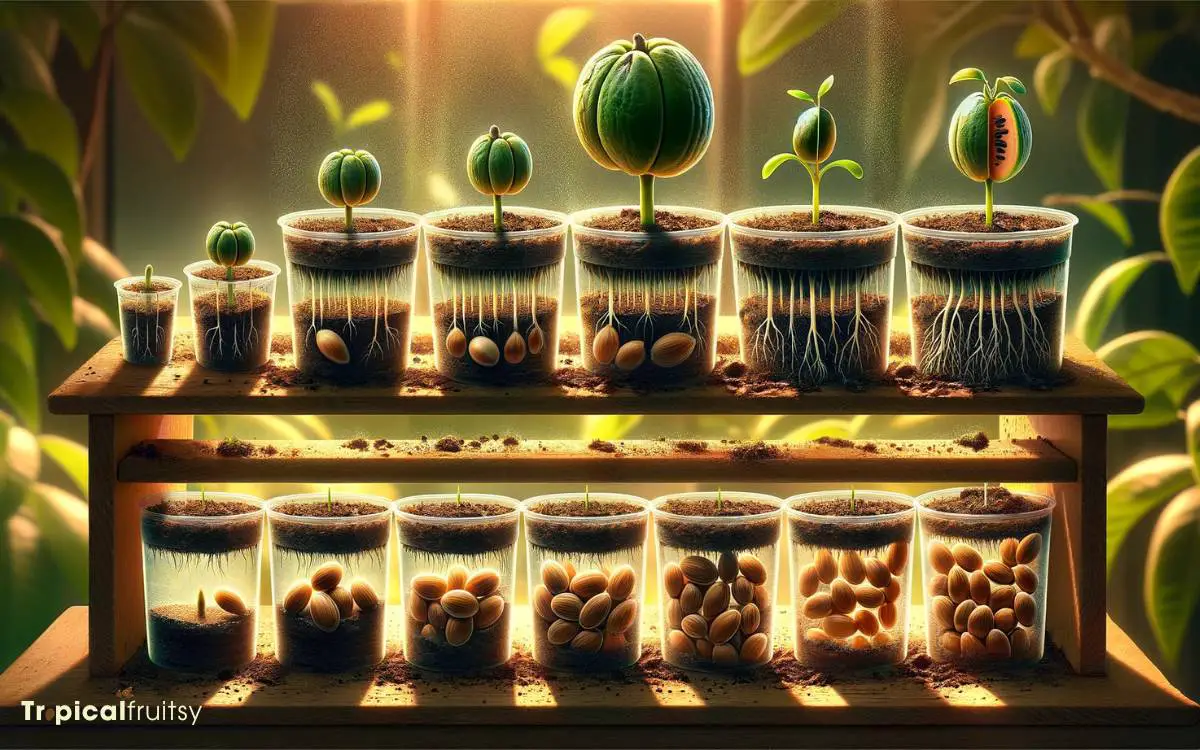
Germination begins when you plant feijoa seeds in a well-draining soil mix after extracting them from ripe fruit. For optimal results, one should clean the seeds thoroughly to remove any pulp, which can inhibit growth and foster mold.
It’s crucial to sow the seeds at a shallow depth, approximately twice the size of the seed itself, ensuring adequate contact with the soil.
The medium must remain moist but not waterlogged, as feijoa seeds require consistent moisture to trigger germination.
Covering the container with a clear plastic lid or wrap can help retain humidity. Germination typically occurs within three to four weeks if maintained at the appropriate temperature range discussed previously.
With seeds sprouting, the focus shifts to providing the right conditions for the young plants, leading into the next stage of potting and initial care.
Step 4: Potting and Initial Care
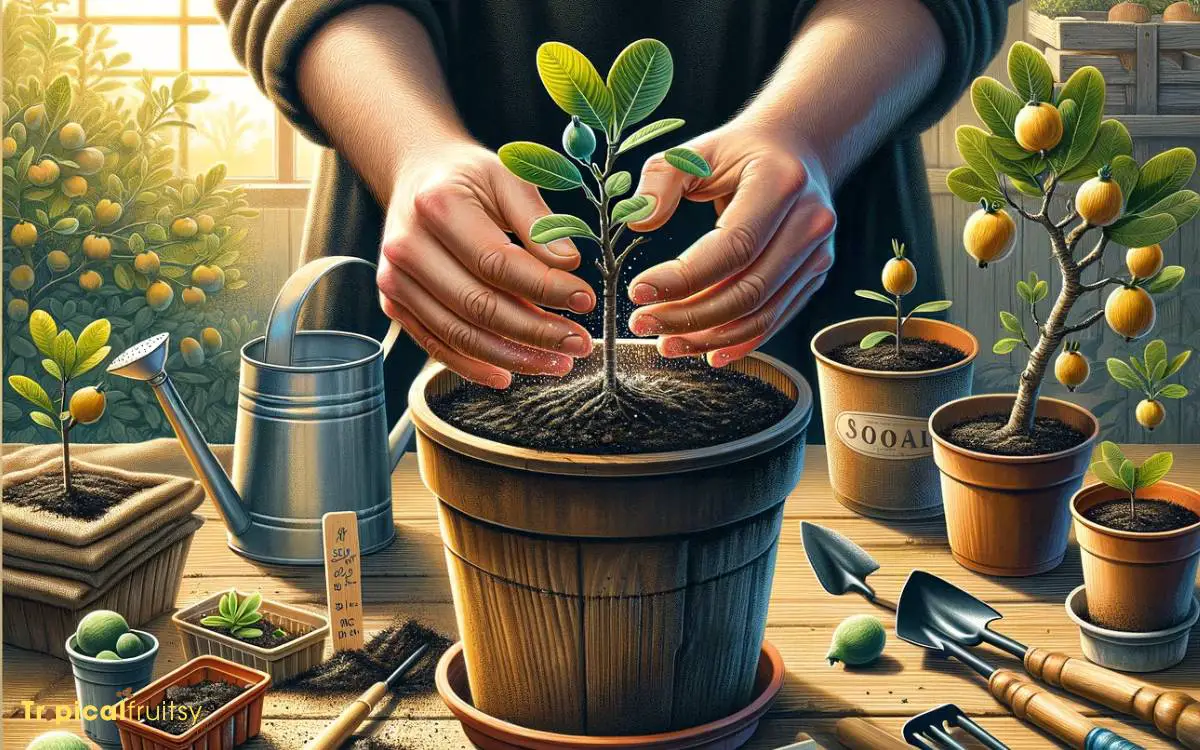
Once the feijoa seedlings have sprouted, it’s time to transfer them to individual pots filled with rich, well-draining soil to ensure healthy growth.
The pots should provide ample space for the roots to expand and facilitate proper water management to prevent root rot.
At this stage, the gardener must focus on these critical care aspects:
- Soil Composition: Utilize a mix of peat, compost, and perlite to create an environment that retains moisture yet drains excess water effectively.
- Light Requirements: Place the pots in a location where the young feijoa plants receive bright, indirect sunlight for most of the day.
- Watering Schedule: Maintain consistent moisture in the soil, but allow the top layer to dry out slightly between waterings to encourage strong root development.
Step 5: Transplanting to the Garden
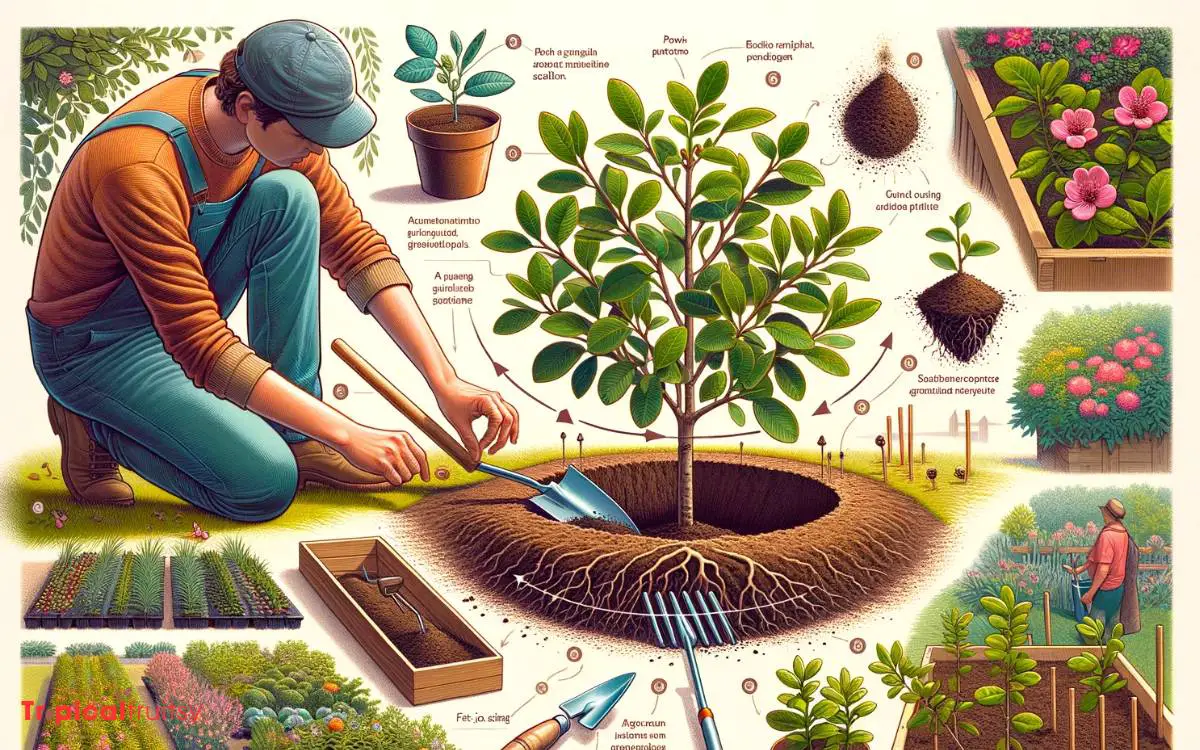
Once feijoa seedlings have established a robust root system in pots, it’s crucial to transition them to the garden with care.
Proper soil preparation enhances the chances of successful transplantation, ensuring the soil’s pH, structure, and nutrient content are suitable for feijoa growth.
Gardeners must also consider the timing of transplantation to coincide with favorable weather conditions, avoiding extremes that may stress the young plants.
Soil Preparation
Proper soil preparation is crucial when one’s ready to transplant feijoa seedlings into the garden. The soil must meet specific conditions to ensure the young plants can establish themselves and thrive.
Here’s how gardeners should prepare the planting site:
- Drainage: Feijoa plants require well-draining soil to prevent root rot. Amend compacted or clay-heavy soil with organic matter like compost or well-rotted manure to improve soil structure and drainage.
- pH Level: The ideal soil pH for feijoa is slightly acidic to neutral, ranging from 5.5 to 7.0. Conduct a soil test and, if necessary, adjust the pH using lime (to raise pH) or sulfur (to lower pH).
- Nutrient Content: Enrich the soil with a balanced, slow-release fertilizer to provide the necessary nutrients for growth. Ensure the soil is rich in organic matter to enhance fertility and water retention.
Root System Care

Caring for the root system is the next crucial step after transplanting your feijoa seedlings into the prepared garden soil. Proper care ensures healthy growth and prevents transplant shock, which can severely impact the young plants.
The table below illustrates important aspects of root system care:
| Care Aspect | Description |
|---|---|
| Watering | Maintain consistent moisture; avoid waterlogging. |
| Soil Composition | Ensure rich, well-draining soil with organic matter. |
| Mulching | Apply mulch to conserve moisture and regulate soil temperature. |
| Root Inspection | Check for signs of disease or pests regularly. |
Attend to these details meticulously. Regular watering helps the roots establish, but be careful not to overwater. Enriching the soil with organic compost provides the nutrients necessary for growth.
Mulching conserves water and protects the roots from extreme temperatures, while routine inspections safeguard against potential threats to the root system’s health.
Timing and Weather
Choosing the right time to transplant feijoa seedlings outdoors is essential, as these plants require temperate conditions free from frost risk.
Gardeners should consider the following factors:
- Local Frost Dates: Transplant after the last expected frost to avoid cold damage to the young plants.
- Soil Temperature: Ensure the soil has warmed to at least 50°F (10°C), which promotes healthy root development.
- Weather Forecast: Monitor the 10-day forecast for unexpected cold snaps or severe weather that could impact the seedlings’ transition to the garden.
By adhering to these guidelines, cultivators increase the chances of successful feijoa establishment and growth.
As the seedlings adapt to their new environment, attention must then shift to ongoing feijoa plant maintenance.
Step 6: Feijoa Plant Maintenance
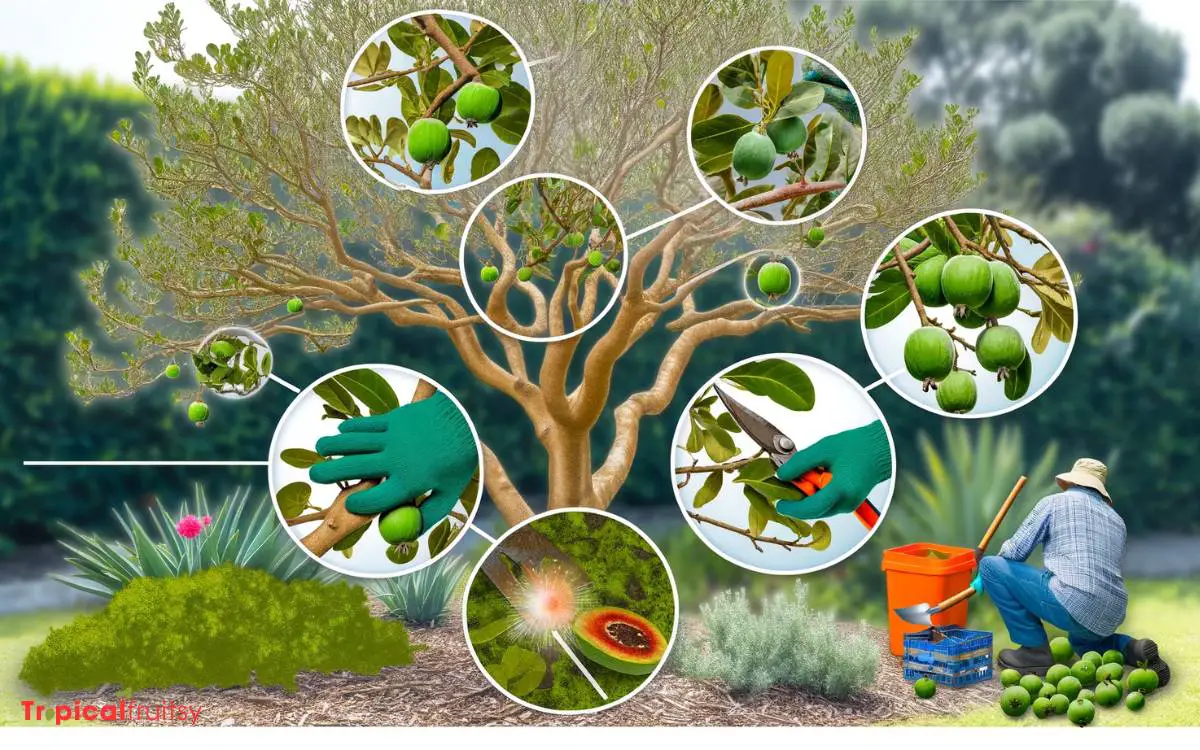
Maintaining a feijoa plant requires consistent watering, adequate sunlight, and periodic fertilization to ensure healthy growth and fruit production.
Gardeners should provide a feijoa with a well-drained soil medium and full to partial sun exposure. It is also crucial to manage the plant’s nutrient intake; a balanced, slow-release fertilizer supports its development.
Pruning is necessary to maintain shape and remove dead or diseased branches, thus promoting better air circulation and sunlight penetration.
| Aspect | Details |
|---|---|
| Watering | Regular, to keep soil moist |
| Sunlight | Full to partial sun |
| Fertilization | Balanced, slow-release |
| Pruning | Annually, for health |
These maintenance practices will not only enhance the feijoa’s vitality but also maximize its yield, offering a bountiful harvest to those who carefully tend to their plant.
Step 7: Troubleshooting Common Issues
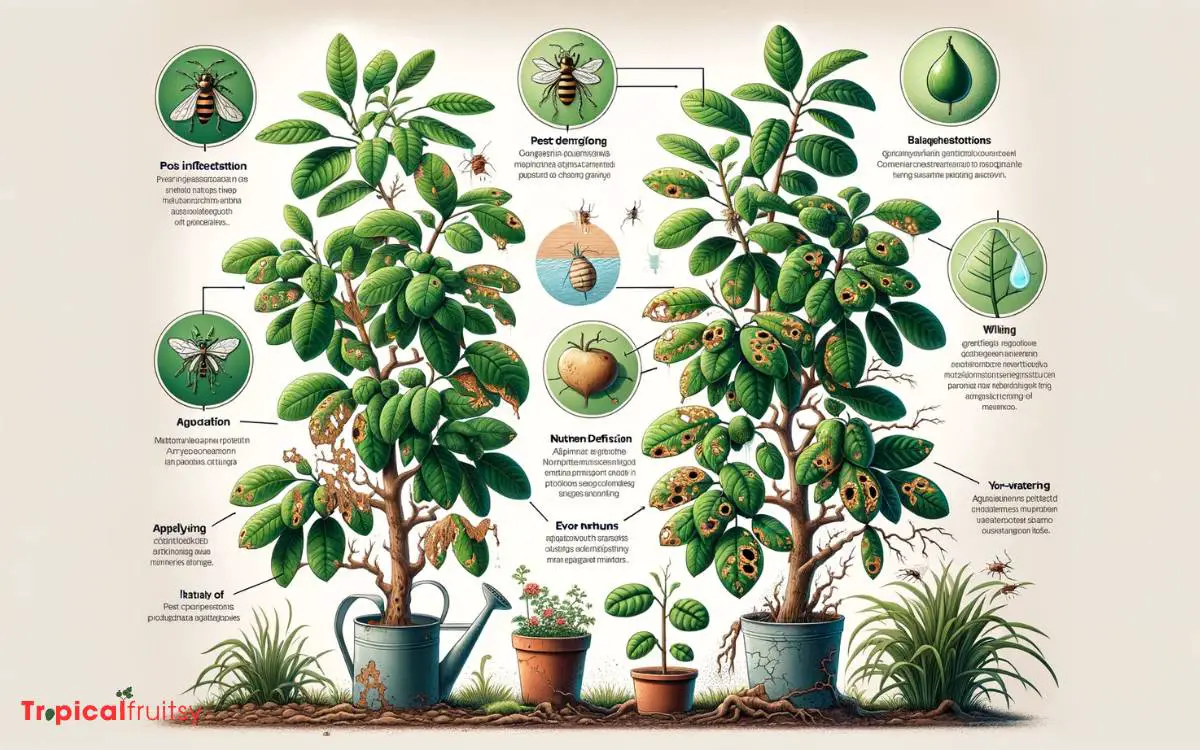
When growing feijoa from fruit, gardeners may encounter several common issues that require prompt and effective solutions.
To maintain the health and productivity of feijoa plants, it’s essential to identify and address these problems early.
Here’s a list of common issues:
- Poor Germination: Feijoa seeds need a warm, moist environment to germinate. If conditions aren’t ideal, germination rates can be low. Consistent temperature and humidity are critical.
- Pest Infestations: Sap-sucking insects like aphids can weaken young plants. Regular inspections and appropriate organic or chemical treatments are necessary to manage these pests.
- Fungal Diseases: Overly damp conditions can lead to root rot or other fungal diseases. Ensuring proper soil drainage and air circulation helps prevent such infections.
Conclusion
Cultivating feijoa from seed is a journey from fruit to flourish, a simple yet rewarding act of agricultural alchemy.
By selecting quality seeds, ensuring proper germination, and providing meticulous care, gardeners can transform tiny kernels into bountiful feijoa bushes.
As each seedling takes root, patience and precision become the gardener’s closest allies, paving the way for a lush, fruit-bearing future. Remember, even the mightiest orchard began as a single seed—nurture yours well.

